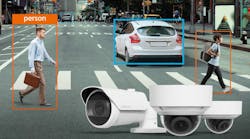The importance of advanced security systems cannot be overstated in the rapidly evolving digital landscape. The increasing complexity of threats and the expansion of interconnected devices and systems demand more sophisticated and dynamic approaches to surveillance and security.
Enter the integration of Internet of Things (IoT) technology with traditional security systems, a convergence that promises to revolutionize how we monitor, protect, and interact with our environments. Organizations can unlock smarter, more efficient surveillance solutions by embedding IoT technology within security frameworks. These integrated systems offer enhanced monitoring and response capabilities and open new avenues for data analysis and operational insights, making security operations more proactive and predictive.
The Rise of IoT in Security Systems
IoT technology encompasses a wide range of devices and systems connected to the internet, capable of collecting and exchanging data. From smart cameras and sensors to access control systems and alarms, IoT devices are becoming integral components of modern security operations. Their relevance extends beyond mere convenience, offering real-time data collection, enhanced connectivity, and unparalleled control over security infrastructure.
The evolution of security systems has seen a significant shift from traditional, isolated setups to network infrastructure that is integrated and enhanced by IoT technologies. This transformation has not only expanded security systems' capabilities but also improved their efficiency and effectiveness.
Integrated, IoT-enhanced networks enable seamless communication between devices, allowing for comprehensive monitoring that covers every corner of a facility or operation. This holistic approach to security ensures that potential threats are identified and addressed promptly, with data from various sources being analyzed to provide a clearer understanding of security situations. The result is a more responsive, adaptable, and intelligent security system capable of meeting the challenges of the modern world.
Key Benefits of IoT-Integrated Security Systems
Enhanced Surveillance Capabilities -- Integrating Internet of Things (IoT) technology into security systems significantly enhances surveillance capabilities. IoT devices, including smart cameras and sensors, bring advancements such as high-quality video resolution, facial recognition, and motion detection to the forefront of security efforts. These features allow for more detailed monitoring, identifying individuals in various conditions, and detecting movements in restricted areas. The enhanced visual capabilities ensure that security operations can cover more ground with greater accuracy, reducing blind spots and increasing the effectiveness of surveillance activities.
Real-Time Monitoring and Alerts -- One of the standout benefits of IoT-integrated security systems is their capacity for real-time monitoring and instant alerts. IoT technology facilitates the immediate data transmission from surveillance devices to security personnel or automated systems. This capability means that any unusual activity or security breach can be identified and addressed promptly, significantly reducing response times and potentially mitigating risks before they escalate. The instant alert system ensures that security teams are always aware of the situation on the ground, enabling a swift and coordinated response to incidents.
Advanced Data Analytics -- IoT technology transforms security systems into rich data sources, enabling the collection and analysis of vast amounts of information. When processed through advanced analytics, this data can reveal patterns, trends, and potential security threats that might not be visible to the human eye.
Predictive analytics can forecast potential security breaches by identifying suspicious behaviors or anomalies in the data stream. This proactive approach to security, powered by IoT and data analytics, allows organizations to anticipate and mitigate risks, making security operations reactive but also predictive and preventative.
Best Practices for Integrating IoT into Security Systems
Integrating Internet of Things (IoT) technology into security systems necessitates careful consideration of several best practices to ensure the security, efficiency, and scalability of the solution. Here are key practices to follow.
Network Security and Data Protection -- Securing IoT devices, their networks, and their sensitive data is paramount to safeguard against cyber threats and prevent data breaches. It involves implementing robust encryption for data transmission, securing device access with strong authentication methods, and regularly updating device firmware to address security vulnerabilities. Additionally, employing network segmentation can limit the potential impact of a compromised device, ensuring that attackers cannot easily access the entire network.
Scalability and Compatibility -- For IoT security solutions to be effective long-term, they must be scalable and compatible with existing security infrastructure. Choosing IoT devices and platforms that can easily integrate with current systems and expand as security needs evolve is important. This foresight prevents costly overhauls and ensures a smoother transition as new technologies emerge or as the scope of security operations grows.
User Training and Policy Development -- Successfully integrating IoT into security systems is not just a technical challenge but also an operational one. Comprehensive staff training is essential to ensure that all users understand how to use IoT-enhanced security tools effectively and recognize potential security threats.
Clear policy development regarding IoT devices, data handling, and response protocols is also crucial. These policies should address privacy concerns, outline procedures for device management, and establish guidelines for data analysis and taking action based on IoT-generated insights.
Overcoming Challenges in IoT Integration
Integrating IoT with security systems presents challenges, such as navigating technical complexity, addressing privacy concerns, and managing the need for ongoing maintenance. To overcome these obstacles, organizations should start by selecting reliable technology partners with a proven track record in IoT security solutions. These partners can provide the expertise needed to navigate the technical complexities and ensure that the IoT integration is done securely and effectively.
Adopting industry best practices for data protection and device management can help mitigate privacy concerns and ensure IoT devices are secure against potential threats. Regular training and updates are crucial for maintaining the security integrity of the system and addressing the ongoing maintenance needs of IoT devices.
Future Trends in IoT and Security Integration
The future of IoT and security integration looks promising, with advancements in artificial intelligence (AI) and machine learning poised to enhance security systems further. These technologies can analyze the vast amounts of data generated by IoT devices more efficiently, predicting potential security threats with greater accuracy and enabling smarter, more proactive surveillance solutions.
Additionally, integrating AI and machine learning could automate response protocols, streamline security operations, and reduce the need for manual intervention. As IoT technology evolves, we expect to see even more innovative applications that bolster security measures and operational efficiency.
Wrapping Up
Integrating IoT technology into security systems offers many benefits, including enhanced surveillance capabilities, real-time monitoring and alerts, and the ability to leverage advanced data analytics for predictive security measures. By embracing IoT technology, security professionals and organizations can significantly strengthen their surveillance and security operations, making them more efficient, responsive, and intelligent.
However, to fully realize these benefits, careful planning and implementation are essential, along with considering potential challenges such as technical complexity, privacy issues, and the need for ongoing maintenance. With the right approach and support from reliable technology partners, the future of security and surveillance powered by IoT integration holds tremendous potential for innovation and enhancement.



